Measurements | Term 1 Chapter 2 | 7th Maths - Area of the rhombus | 7th Maths : Term 1 Unit 2 : Measurements
Chapter: 7th Maths : Term 1 Unit 2 : Measurements
Area of the rhombus
Rhombus
Take four sticks of equal length and four connectors. Connect four
sticks to form a square as shown in the Fig.2.11(i). Then, try to make any two
opposite vertices closer as shown in the Fig.2.11(ii) such that opposite sides
remain parallel to each other to get a new shape called rhombus.
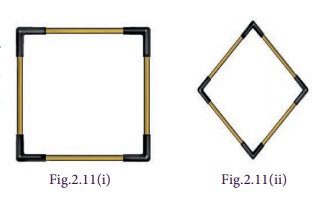
Hence, we conclude that, in a parallelogram, if
all the sides are equal then it is called a rhombus.
Note
In a rhombus, (i) all the sides
are equal (ii) opposite sides are parallel (iii) diagonals divide the rhombus
into 4 right angled triangles of equal area. (iv) the diagonals bisect each
other at right angles.
1.
Area of the rhombus if base and height are given
Draw a rhombus on a graph sheet as shown in the
Fig.2.12(i) and cut it. Draw a perpendicular line from one vertex to the
opposite side. Cut the triangle and shift the triangle to the other side of the
rhombus as shown in the Fig.2.12(ii).What shape do you see? It is a square.
Hence, the area of the rhombus is the same as that of the square.
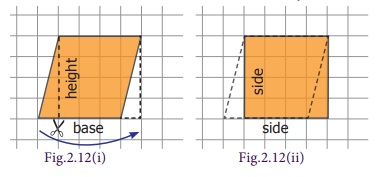
Area of the square
= side ×
side sq.units
= base ×
height sq.units
= area
of the rhombus
2.
Area of the rhombus if the diagonals are given
Let us find, area of the rhombus ABCD by
splitting it into two triangles.
Here AB = BC = CD = DA and diagonals AC (d1)
and BD (d2)
are perpendicular to each other.
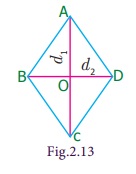
Area of the rhombus ABCD = Area of triangle ABC
+ Area of triangle ADC
= 1/2 ×
AC × OB + 1/2 × AC × OD
= 1/2 ×
AC (OB+OD)
= 1/2 ×
AC × BD
= 1/2 × d1 × d2 sq. units
Therefore, area of the rhombus = 1/2 (product
of diagonals) square units.
Try these
1. Observe the Fig. 2.14 and
answer the following questions.
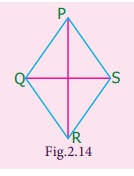
(i) Name two pairs of opposite
sides.
Two pairs of opposite sides
PQ and RS, QR and PS.
(ii) Name two pairs of adjacent
sides.
Two pairs of adjacent sides
PQ and QR, PS and RS.
(iii) Name the two diagonals
Two diagonals PR and QS.
2. Find the area of the rhombus
given in Fig. 2.15 and Fig. 2.16
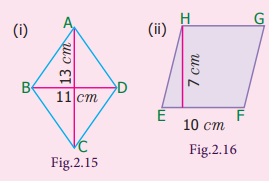
(i) d1 = 11 cm,
d2 = 13 cm
Area of the rhombus = ½ d1 × d2
sq.units
= 1/2 × 11 ×
13 sq.cm
= 143 / 2 =
71.5
sq.cm
(ii) base b = 10 cm
height h = 7 cm
Area of the rhombus = b × h
sq .units
= 10 × 7 = 70 sq. cm
Example 2.6
Find the area of the rhombus whose side is 17 cm and the height is 8 cm.
Solution
Given:
Base = 17 cm, height = 8 cm
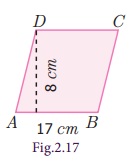
Area of the rhombus = b × h sq. units
= 17 × 8 = 136
Therefore, area of the rhombus = 136 sq. cm.
Think
1. Can you find the perimeter of
the rhombus?
2. Can diagonals of a rhombus be
of the same length?
3. A square is a rhombus but a
rhombus is not a square. Why?
4. Can you draw a rhombus in such
a way that the side is equal to the diagonal.
Example 2.7
Calculate the area of the rhombus having
diagonals equal to 6 m and 8 m.
Solution
Given: d1 =
6 m, d2 =
8 m
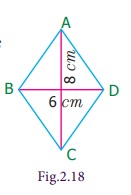
Area of the rhombus = 1/2 × (d1 × d2) sq. units
= 1/2 ×
(6 × 8)
= 48/2
= 24 sq.m
Hence, area of the rhombus is 24 sq.m.
Example 2.8
If the area of the rhombus is 60 sq. cm and one of the diagonals is 8 cm, find the length of the other diagonal.
Solution
Given, the length of one diagonal (d1)
= 8 cm
Let, the length of the other diagonal be d2
cm
Area of the rhombus = 60 sq. cm (given)
1/2 × (d1× d2) = 60
1/2 × (8× d2)
= 60
8 × d2
= 60 × 2
d2 = 120/8
= 15
Therefore, length of the other diagonal is 15 cm.
Example 2.9
The floor of an office building consists of 200
rhombus shaped tiles and each of its length of the diagonals are 40 cm and 25 cm. Find the total cost of polishing the floor at
₹ 45 per sq.m.
Solution
Given, the length of the diagonals of a rhombus
shaped tile are 40 cm and 25 cm
The area of one tile = 1/2 × (d1×
d2 ) sq. units
= 1/2 × 40 × 25
= 500 sq. cm
Therefore, the area of 200 such tiles = 200 ×
500
= 100000
sq. cm
= 100000/10000
(1 sq. m = 10000 sq.
cm)
= 10 sq. m
Therefore, the cost of polishing 200 such tiles
at the rate of ₹ 45 per sq.
cm = 10 × 45 = ₹ 450.

In railway the terminology,
“Diamond Crossing” refers to the point
where two railway lines cross, forming the shape of rhombus at the crossing
point. The most famous diamond crossing is at Nagpur, where lines from the
North, South, East, and Western railways meet.
Related Topics